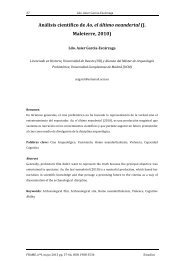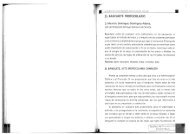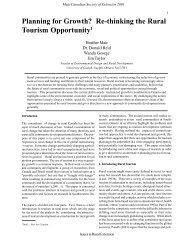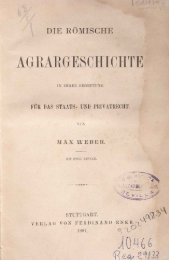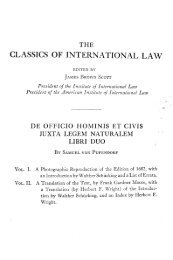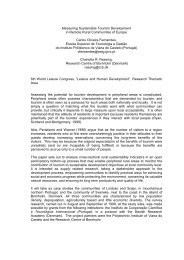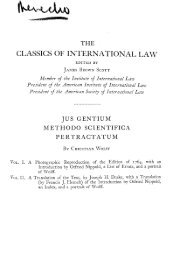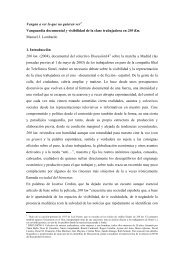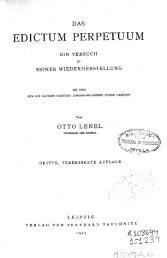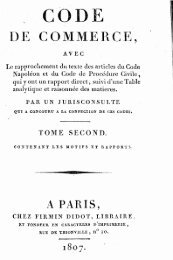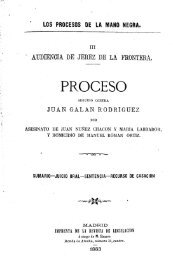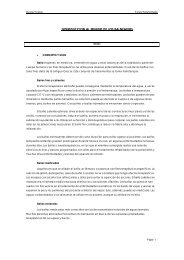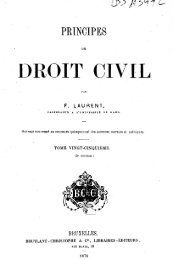Tourism and Place Identity: A case-study in rural Ireland
Tourism and Place Identity: A case-study in rural Ireland
Tourism and Place Identity: A case-study in rural Ireland
Create successful ePaper yourself
Turn your PDF publications into a flip-book with our unique Google optimized e-Paper software.
<strong>Tourism</strong> <strong>and</strong> <strong>Place</strong> <strong>Identity</strong>: A <strong>case</strong>-<strong>study</strong> <strong>in</strong> <strong>rural</strong> Irel<strong>and</strong><br />
Moya Kneafsey<br />
School of Natural <strong>and</strong> Environmental Sciences, Coventry University<br />
ABSTRACT<br />
This paper aims to exam<strong>in</strong>e aspects of the relationship between tourism <strong>and</strong> place identity<br />
<strong>in</strong> <strong>rural</strong> Irel<strong>and</strong>. This relationship is conceptualised <strong>in</strong> terms of the seem<strong>in</strong>gly contradictory<br />
themes of change <strong>and</strong> cont<strong>in</strong>uity <strong>and</strong>, through a <strong>case</strong> <strong>study</strong>, it is argued that the<br />
impact of tourism must be understood <strong>in</strong> terms of the new social relations which emerge<br />
as <strong>in</strong>dividuals <strong>and</strong> <strong>in</strong>stitutions <strong>in</strong>teract to commodify place identity. These new relations<br />
<strong>in</strong> turn are mediated through resilient exist<strong>in</strong>g social relations. Whilst there is evidence<br />
of a gradual redef<strong>in</strong>ition of local identities towards a more touristic orientation through,<br />
for example, the commodification of cultural practices, heritage <strong>and</strong> l<strong>and</strong>scape resources,<br />
there is also evidence of resistance to this re-orientation. Thus places reta<strong>in</strong> their dist<strong>in</strong>ct<br />
identities <strong>in</strong> the face of potentially homogenis<strong>in</strong>g global processes.<br />
Key <strong>in</strong>dex words: tourism, place, identity, Irel<strong>and</strong>.<br />
Introduction<br />
It is widely recognised that tourism has become an <strong>in</strong>dustry of major importance <strong>in</strong> the Republic of<br />
Irel<strong>and</strong>, with visitor numbers ris<strong>in</strong>g from 2.5 million <strong>in</strong> 1990 to over five million <strong>in</strong> 1996. European Union<br />
funds <strong>and</strong> public <strong>and</strong> private sector <strong>in</strong>vestments totall<strong>in</strong>g 388.84 million ECU dur<strong>in</strong>g the period 1989-1993,<br />
have helped to improve the roads, <strong>in</strong>frastructure <strong>and</strong> accommodation base, <strong>and</strong> have raised the number of<br />
visitor attractions (Hurley et al.,1994), whilst accessibility has been enhanced through the liberalisation of<br />
air travel <strong>in</strong> the late 1980s (Gillmor, 1994).<br />
An important feature of recent Irish tourism development has been the explosion <strong>in</strong> cultural or heritage<br />
tourism (Duffy, 1994; Mullane, 1994; McManus, 1997). As Richards notes (1996), this is part of a broader<br />
European trend towards the conversion of former production spaces <strong>in</strong>to spaces of consumption.<br />
Coalm<strong>in</strong>es become museums, factories become visitor centres <strong>and</strong>, most relevant to the <strong>case</strong> of Irel<strong>and</strong>,<br />
countryside becomes leisure l<strong>and</strong>scape (Cloke, 1993). Cultural tourism is no longer restricted to the ma<strong>in</strong>ly<br />
visual consumption of ‘high culture’ artefacts such as galleries, theatres <strong>and</strong> architecture, but has<br />
exp<strong>and</strong>ed to <strong>in</strong>clude simply “soak<strong>in</strong>g up the atmosphere” of a place (Richards, 1996), sampl<strong>in</strong>g the local<br />
food (Ilbery <strong>and</strong> Kneafsey, 1998; Bessière, 1998), <strong>and</strong> participat<strong>in</strong>g <strong>in</strong> local events. In Irel<strong>and</strong>, cultural<br />
tourism has been particularly developed <strong>in</strong> the form of heritage attractions such as historic houses, <strong>in</strong>terpretative<br />
centres, parks <strong>and</strong> monuments (O’Donnchadha <strong>and</strong> O’Connor, 1996). In addition to historical or<br />
heritage attractions, the people of Irel<strong>and</strong> <strong>and</strong> their lifestyles are seen as a key component of the cultural<br />
tourism product. Hospitality, humour <strong>and</strong> the relaxed pace of life are all emphasised as part of the appeal<br />
of a holiday <strong>in</strong> Irel<strong>and</strong> (Browne 1994). Aer L<strong>in</strong>gus (1998), for <strong>in</strong>stance, claims that “Irish hospitality beg<strong>in</strong>s<br />
<strong>in</strong> the air”, whilst Irish Ferries (1998) emphasise the warm welcome which will be provided by their staff:<br />
“Have you heard the one about the unfriendly Irishman? Neither have we”. Travel articles too emphasise<br />
the gregarious nature of the Irish, who always make time to “chat on a street corner” or “meet new friends<br />
over a p<strong>in</strong>t” (Geographical, 1998).<br />
Rural tourism has been encouraged by EU policies such as the 1990 European Year of <strong>Tourism</strong> <strong>and</strong><br />
LEADER programmes which seek to promote tourism as a means of ‘bottom-up’ local development<br />
(Jenk<strong>in</strong>s, Hall <strong>and</strong> Troughton, 1998). In <strong>rural</strong> areas the human resource is regarded as be<strong>in</strong>g of special<br />
importance <strong>and</strong> successful tourism is seen as be<strong>in</strong>g dependent on the active engagement of local people.<br />
Irish Geography, Volume 31(2), 1998, 111-123.
112 Kneafsey<br />
This participation <strong>in</strong> turn is viewed as a means of regenerat<strong>in</strong>g crumbl<strong>in</strong>g senses of place identity <strong>and</strong> provid<strong>in</strong>g<br />
communities with “the occasion for a new self-reflection: a cultural exam<strong>in</strong>ation of conscience”<br />
(Feehan, 1992: 21).<br />
In summary, therefore, Irish tourism over the last decade or so has been characterised by rapid growth,<br />
with particular emphasis on the use of cultural or heritage tourism to promote ‘bottom-up’ development <strong>in</strong><br />
<strong>rural</strong> areas (Deegan <strong>and</strong> D<strong>in</strong>een, 1997; Keane <strong>and</strong> Qu<strong>in</strong>n, 1990). The emergence of this k<strong>in</strong>d of all-encompass<strong>in</strong>g<br />
tourism has implications for the people who live <strong>in</strong> tourist dest<strong>in</strong>ations, people who themselves<br />
become part of the tourist product. For <strong>in</strong>stance, O’Connor (1993: 73) suggests that one of these implications<br />
is that “Irish people become <strong>in</strong>scribed with<strong>in</strong> tourist expectations. Tourists expect a certa<strong>in</strong> type of<br />
behaviour <strong>and</strong> are disappo<strong>in</strong>ted if these expectations are not met.” This paper aims to explore these implications<br />
further through a <strong>case</strong> <strong>study</strong> of tourism development <strong>in</strong> the small town of Foxford, County Mayo.<br />
It is suggested that the response to the expectations generated by tourists is mediated through the resilient<br />
local social relations which exist with<strong>in</strong> the host community. Sometimes the response may be characterised<br />
<strong>in</strong> terms of change; at other times, it may be characterised as cont<strong>in</strong>uity. In the follow<strong>in</strong>g section, an<br />
attempt is made to conceptualise these responses <strong>in</strong> terms of the relationship between tourism <strong>and</strong> place<br />
identity.<br />
Conceptualis<strong>in</strong>g <strong>Tourism</strong> And <strong>Place</strong> Identities In Irel<strong>and</strong><br />
It is broadly agreed that tourism has an impact on place identities. What is not agreed is the extent <strong>and</strong><br />
nature of that impact. In this paper, the phrase ‘place identities’ is used to capture the broad range of social<br />
relations which contribute to the construction of a ‘sense of place’, a sense which enables people to feel<br />
that they ‘belong’ to a place, or that a place ‘belongs’ to them. The idea is to explore the ways <strong>in</strong> which<br />
tourism may cut across the particular ‘lifeworlds’ (Butz <strong>and</strong> Eyles, 1991) <strong>and</strong> experiences of certa<strong>in</strong> groups<br />
of people <strong>and</strong> to try <strong>and</strong> convey a sense of the complexities <strong>and</strong> conflicts surround<strong>in</strong>g the construction of<br />
place identities. The plural ‘identities’ is used to suggest that different versions of identity may circulate<br />
with<strong>in</strong> a place, versions which are shaped by the <strong>in</strong>dividual or collective experiences of different people.<br />
In terms of conceptualis<strong>in</strong>g the relationship between tourism <strong>and</strong> place identities, two broad themes can be<br />
identified with<strong>in</strong> the tourism studies literature. In the follow<strong>in</strong>g section, these themes are outl<strong>in</strong>ed <strong>and</strong> a<br />
third, alternative conceptualisation is then <strong>in</strong>troduced.<br />
<strong>Tourism</strong> constructs or reconstructs place identities<br />
The first theme is that place identities are (re)constructed <strong>in</strong> order to meet tourist desires for particular<br />
characteristics such as authenticity <strong>and</strong> tradition (Urry, 1990; 1995). In the <strong>case</strong> of Irel<strong>and</strong> it has been suggested<br />
that, <strong>in</strong> the context of construct<strong>in</strong>g an image for tourism promotional purposes, tourism images <strong>and</strong><br />
texts are important to the construction of national identity. For <strong>in</strong>stance, Gibbons (cited <strong>in</strong> O’Connor, 1993)<br />
argues that tourist images are a source of dom<strong>in</strong>ant visual representations of the nation. Similarly,<br />
O’Connor (1993: 69) argues that tourist imagery “plays a significant role <strong>in</strong> provid<strong>in</strong>g a native self-image”<br />
because firstly, Irish people have been exposed to tourist representations over a long period of time; <strong>and</strong><br />
secondly, there has been a high level of contact between tourists <strong>and</strong> locals due to the small scale of the<br />
isl<strong>and</strong> <strong>and</strong> its population <strong>and</strong> the large proportion of tourists who are ‘visit<strong>in</strong>g friends <strong>and</strong> relatives.’<br />
The forms which this construction of national self-image has taken have been explored through analyses<br />
of the ways <strong>in</strong> which certa<strong>in</strong> touristic images of place have been constructed on the basis of historically-rooted<br />
perceptions of the country <strong>and</strong> its <strong>in</strong>habitants as the romanticised ‘other’ to entities such as<br />
‘Engl<strong>and</strong>’, ‘modern society’ <strong>and</strong> ‘urban <strong>in</strong>dustrialised Europe’. Bell (1995: 42) for <strong>in</strong>stance, notes that Irish<br />
tourist agencies “draw on the ‘melancholy vision’ of the northern Romantic tradition of l<strong>and</strong>scape pa<strong>in</strong>t<strong>in</strong>g<br />
to capture the imag<strong>in</strong>ation of the potential German tourist”. Similarly, Qu<strong>in</strong>n (1994: 64), <strong>in</strong> her <strong>study</strong> of<br />
images of Irel<strong>and</strong> <strong>in</strong> Europe, observes that the overwhelm<strong>in</strong>g message is that “Irel<strong>and</strong> is a world apart from
<strong>Tourism</strong> <strong>and</strong> <strong>Place</strong> <strong>Identity</strong> 113<br />
modern society” which offers “genu<strong>in</strong>e unspoilt l<strong>and</strong>scapes” <strong>and</strong> “the chance to rediscover old world values.”<br />
The West of Irel<strong>and</strong> <strong>in</strong> particular is used to symbolise Irel<strong>and</strong> <strong>and</strong> Irishness. As Nash (1993: 86) writes,<br />
“Images of the western l<strong>and</strong>scape function <strong>in</strong> promotional publications as a shorth<strong>and</strong> notation for the l<strong>and</strong>scape<br />
of Irel<strong>and</strong> <strong>in</strong> general.” She shows that historically, the West was constructed both <strong>in</strong> opposition to<br />
Englishness <strong>and</strong> with<strong>in</strong> Irel<strong>and</strong> as a site of true Irishness. The people of the West were endowed with particular<br />
qualities rang<strong>in</strong>g from lawlessness, sensuality <strong>and</strong> physicality <strong>in</strong> the writ<strong>in</strong>gs of Synge, to peasant<br />
resilience, puritanism <strong>and</strong> courage <strong>in</strong> the vision of nationalists such as Pearse <strong>and</strong> MacNeill (Gibbons,<br />
1996; see also Duffy, 1997; Graham, 1997; Johnson, 1997; Brett, 1994; Kockel, 1994). Some of these connotations<br />
are susta<strong>in</strong>ed <strong>in</strong> contemporary tourism images <strong>and</strong> texts. For <strong>in</strong>stance, Uris (1978: 60) writes of<br />
the West as “the Irish conscience,” describ<strong>in</strong>g its people as “the gentle beauty of Irel<strong>and</strong>, soft <strong>and</strong> unsophisticated<br />
yet so full of wisdom <strong>and</strong> so dogged”, “the last great peasantry of Europe”, <strong>and</strong> the “backbone<br />
of the race.” More recent sources describe it as a l<strong>and</strong> which “embodies all the stereotypes generally associated<br />
with the country” (Howard, 1998:98) where the <strong>in</strong>habitants have “clung to their own traditions <strong>in</strong><br />
spite of the past <strong>in</strong>vaders <strong>and</strong> the more <strong>in</strong>sidious advances of modern life” (Day, 1995: 228).<br />
Whilst it may be that touristic representations contribute to the construction of dom<strong>in</strong>ant images or perceptions<br />
of Irel<strong>and</strong> <strong>and</strong> the Irish, little primary research has been conducted <strong>in</strong>to the relationship between<br />
tourism <strong>and</strong> other aspects of local place identity such as sense of place, the relationships which tie people<br />
to places, or the cultural, social <strong>and</strong> economic practices which help def<strong>in</strong>e <strong>in</strong>dividuals’ perceptions of<br />
places. Yet, as this paper hopes to demonstrate, it is these features which shape the ways <strong>in</strong> which communities<br />
respond to touristic images or expectations of themselves.<br />
<strong>Tourism</strong> destroys unique place identities<br />
The second broad argument is that tourism destroys unique place identities. MacCannell (1992) for<br />
example, writes that commodification leads to the ‘death’ of third-world <strong>and</strong> ethnic cultures <strong>and</strong> the<br />
destruction of authenticity. Similarly, authors such as Greenwood (1989) <strong>and</strong> Mason (1996) argue that<br />
tourism results <strong>in</strong> the ‘destruction’ or ‘prostitution’ of once unique cultures. In reference to Irel<strong>and</strong>, Brody<br />
(1972) suggests that <strong>rural</strong> communities may become dependent on tourists for reassurance <strong>and</strong> self-worth,<br />
whilst Byrne et al. (1993) feel that <strong>in</strong> adapt<strong>in</strong>g to tourism, hosts <strong>in</strong> Connemara conform to the expectations<br />
of visitors from more politically <strong>and</strong> economically powerful cultures. In the process, unique cultural identities<br />
are eroded:<br />
“[W]hen <strong>in</strong>digenous <strong>in</strong>habitants of places like the West of Irel<strong>and</strong> gradually ab<strong>and</strong>on local criteria<br />
regulat<strong>in</strong>g forms of reasonable thought <strong>and</strong> feel<strong>in</strong>g, they will have become much more similar<br />
to people everywhere else” (p. 253).<br />
Furthermore, critics of the rapidly developed heritage <strong>in</strong>dustry <strong>in</strong> Irel<strong>and</strong> have accused it, among other<br />
th<strong>in</strong>gs, of creat<strong>in</strong>g ‘twee’ (McDonald, Irish Times, 22/9/92), ‘jumbled’, ‘folksy’ (Busteed, 1992) ‘stereotypical’,<br />
‘nostalgic’ <strong>and</strong> ‘biased’ (Mullane, 1994) images of Irel<strong>and</strong> <strong>and</strong> the Irish. An over-arch<strong>in</strong>g theme<br />
of these criticisms is the idea that heritage centres contribute to the ‘tr<strong>in</strong>ketisation’, commercialisation <strong>and</strong><br />
trivialisation of culture.<br />
These critiques of the heritage <strong>in</strong>dustry can be seen as part of a broader vision of tourism as a symptom<br />
of the homogenis<strong>in</strong>g onslaught of global capitalism, whereby places are seen to lose their dist<strong>in</strong>ctive<br />
identities <strong>in</strong> an <strong>in</strong>creas<strong>in</strong>gly bl<strong>and</strong> world of MacDonalds <strong>and</strong> Coca-Cola consumption. Yet, contemporary<br />
conceptualisations stress that cultures can be seen to change, to be constantly contested (Hall, 1995; Crang,<br />
1998). Indeed, it can be argued that globalisation is not new, <strong>and</strong> that even remote places have long been<br />
open to global <strong>in</strong>fluences <strong>and</strong> connections. For <strong>in</strong>stance, as Smyth (1997) po<strong>in</strong>ts out, the fortunes of the<br />
West of Irel<strong>and</strong> have been tied up with those of America’s east coast cities s<strong>in</strong>ce the late sixteenth century.
114 Kneafsey<br />
Furthermore, this historical perspective also highlights the fact that tourism is only one relatively recent<br />
aspect of globalisation <strong>and</strong> hence, <strong>in</strong> the <strong>case</strong> of Irel<strong>and</strong> at least, only one of the many processes which may<br />
potentially contribute to the homogenisation of unique place identities.<br />
An Alternative Conceptualisation: <strong>Tourism</strong>, Change <strong>and</strong> Cont<strong>in</strong>uity<br />
The <strong>in</strong>tention <strong>in</strong> this paper is to arrive at a more balanced appraisal of the relationship between tourism<br />
<strong>and</strong> place identities. Rather than simply (re)construct<strong>in</strong>g or destroy<strong>in</strong>g previously fixed <strong>and</strong> stable place<br />
identities, tourism contributes to on-go<strong>in</strong>g processes of change, whilst at the same time be<strong>in</strong>g mediated<br />
through the elements of cont<strong>in</strong>uity which exist with<strong>in</strong> place identities. As proposed by Oakes (1995),<br />
tourism should, therefore, be thought of as just another process through which localised identities are cont<strong>in</strong>ually<br />
reconstructed. Similarly, Cohen (1988) <strong>and</strong> Black (1996), have recognised that tourism can be<br />
used as a valuable tool <strong>in</strong> the re-assertion or re-evaluation of local identities <strong>in</strong> the face of external pressures.<br />
In other words, tourism can be seen as an example of the unique ways <strong>in</strong> which global-local relations<br />
are negotiated with<strong>in</strong> the context of particular places, thus allow<strong>in</strong>g for the ma<strong>in</strong>tenance of diversity<br />
<strong>and</strong> difference.<br />
Whilst identities may be <strong>in</strong> a constant process of flux <strong>and</strong> change, there are also elements of cont<strong>in</strong>uity<br />
which enable one to talk about a sense of place, to make qualitative, subjective assessments of what<br />
places are like. In each place, the relationship between change <strong>and</strong> cont<strong>in</strong>uity is different, with change<br />
be<strong>in</strong>g more rapid <strong>and</strong> noticeable <strong>in</strong> some locations than <strong>in</strong> others. Although the tourism <strong>in</strong>dustry may seek<br />
to promote un-complicated, easily communicable <strong>and</strong> readily consumed images of place identity, these<br />
constructions exist alongside other deeply-rooted expressions of place identity <strong>and</strong> need not necessarily<br />
dom<strong>in</strong>ate or over-ride all of them. As Boisseva<strong>in</strong> (1996) demonstrates, communities are capable of utilis<strong>in</strong>g<br />
their cultural resources whilst at the same time preserv<strong>in</strong>g spaces of cultural autonomy which rema<strong>in</strong><br />
<strong>in</strong>accessible to tourist expectations. Furthermore, evidence from the <strong>case</strong> <strong>study</strong> shows that some aspects<br />
of local place identities are resilient <strong>and</strong> often resistant to change. The aim of this paper, therefore, is to<br />
illustrate ways <strong>in</strong> which tourism development is mediated through resilient local social relations, whilst at<br />
the same time creat<strong>in</strong>g new social relations which overlay the exist<strong>in</strong>g foundations with<strong>in</strong> a particular<br />
place. It is argued that it is the emergence of these new social relations, rather than the presence of the<br />
tourists themselves which, <strong>in</strong> this <strong>case</strong>, have had most impact on place identity. In the follow<strong>in</strong>g section,<br />
the <strong>case</strong> <strong>study</strong> location is <strong>in</strong>troduced <strong>and</strong> a brief outl<strong>in</strong>e of the research methodologies is presented.<br />
Introduc<strong>in</strong>g the Case Study: Foxford <strong>in</strong> County Mayo<br />
Foxford, a small town with a population of 944 (1996) is located on the banks of the River Moy <strong>in</strong> the<br />
north of county Mayo (Figure 1). Whilst tourism has developed rapidly around the honey-pot of Westport<br />
<strong>in</strong> the south of the county, the north is less well-known <strong>and</strong> it was for this reason that the area was chosen<br />
as the site for a <strong>case</strong> <strong>study</strong>.<br />
The aim was to capture the transition to an <strong>in</strong>creas<strong>in</strong>gly tourism-centred economy <strong>in</strong> a relatively<br />
remote place which is known for its strong cultural identity. In recent years a series of impressive heritage<br />
attractions (Kneafsey, 1995) <strong>and</strong> tourist circuits have been developed, <strong>and</strong> despite problems of accessibility<br />
<strong>and</strong> a relatively poor accommodation base, tourism is seen as an important part of the county’s future<br />
(Mullaly Report, 1989; Mayo County Council, 1995).<br />
<strong>Tourism</strong> images of Mayo draw on the romanticism associated with the West of Irel<strong>and</strong> to claim that<br />
the county is the most Irish part of Irel<strong>and</strong>. A French language brochure, for <strong>in</strong>stance, asks “which is the<br />
only region of Irel<strong>and</strong> which is more Irish than Irel<strong>and</strong>?” The answer, “Mayo, naturally.” Statements such<br />
as these are supported with reproductions of artworks such as Paul Henry’s portrayal of men push<strong>in</strong>g a curragh<br />
out to sea, or Frederick William Burton’s l<strong>and</strong>scapes of Achill. Similarly, English language brochures
<strong>Tourism</strong> <strong>and</strong> <strong>Place</strong> <strong>Identity</strong> 115<br />
Figure 1: Study area.<br />
describe a visit to Mayo as a “journey <strong>in</strong>to an historic past”,<br />
to the “f<strong>in</strong>al frontier of beauty <strong>and</strong> hospitality.” References<br />
to the county’s “scenic splendour”, “roll<strong>in</strong>g hills <strong>and</strong> gentle<br />
valleys” <strong>and</strong> “natural, clean <strong>and</strong> green environment” help to<br />
create an image of this place as one of the last wildernesses.<br />
One of the county’s chief attractions is the “spontaneous<br />
hospitality of a car<strong>in</strong>g people” who are “renowned the<br />
world over for their warm <strong>and</strong> hospitable nature” <strong>and</strong> who<br />
will offer the visitor a “warm welcome.” In the words of the<br />
then m<strong>in</strong>ister for tourism, a resident of <strong>and</strong> political representative<br />
for county Mayo, “the magic of Mayo lies chiefly<br />
<strong>in</strong> the people you will meet dur<strong>in</strong>g your stay” (‘aMayoz<strong>in</strong>g<br />
brochure’, 1995). The Moy Valley brochure similarly<br />
reflects the idea that “it is the warmth of the people that<br />
make Moy Valley the Emerald that is Irel<strong>and</strong>.” In many<br />
respects, Mayo is represented as the archetypal Irish county,<br />
with references to a strong religious element (e.g. Knock<br />
shr<strong>in</strong>e), a turbulent past, a romantic l<strong>and</strong>scape, warm-hearted<br />
people, a different pace of life <strong>and</strong> suggestions of the<br />
opportunity to restore one’s self through a return to nature.<br />
Foxford is seen as a town which is do<strong>in</strong>g well for itself,<br />
largely as a result of the development of a visitor centre<br />
based at a woollen mill. A local Teagasc socio-economic<br />
advisor described it as a “typical small town that was almost<br />
<strong>in</strong>visible before.” One <strong>in</strong>habitant of the town said “Foxford<br />
has thrived over the last couple of years” whilst another<br />
commented “Foxford is gett<strong>in</strong>g a reputation for be<strong>in</strong>g pretty<br />
progressive. Someth<strong>in</strong>g good is happen<strong>in</strong>g.” Foxford is<br />
regarded as someth<strong>in</strong>g of a beacon <strong>in</strong> an area which generally<br />
suffers from high levels of unemployment <strong>and</strong> de-population.<br />
Before look<strong>in</strong>g at some of the reasons as to why<br />
this is so, it is necessary to briefly outl<strong>in</strong>e the research methods<br />
which were adopted for this <strong>study</strong>.<br />
Methodology<br />
The <strong>case</strong> <strong>study</strong> of Foxford forms part of a comparative research project, the other <strong>study</strong> be<strong>in</strong>g that of<br />
a small commune <strong>in</strong> F<strong>in</strong>istère, Brittany (Kneafsey, 1997; 1998). The comparison allowed for a greater<br />
underst<strong>and</strong><strong>in</strong>g of those processes which were generic <strong>and</strong> those which were place-specific. Most importantly,<br />
it provided evidence of the fundamental importance of unique local social relations <strong>in</strong> shap<strong>in</strong>g the<br />
k<strong>in</strong>ds of tourism which develop <strong>and</strong> <strong>in</strong> mediat<strong>in</strong>g the impact of that development.<br />
As Crick (1989, cited <strong>in</strong> O’Connor <strong>and</strong> Cron<strong>in</strong>, 1993) notes, the ‘local voice’ is often absent from studies<br />
of the impacts of <strong>in</strong>ternational tourism (see also Boisseva<strong>in</strong>, 1996). The methodology adopted for this<br />
<strong>study</strong> was guided by a wish to engage with <strong>and</strong> record such local voices, <strong>and</strong> consisted of two ma<strong>in</strong> strategies.<br />
First, participant observation was undertaken throughout the four-month research period. This generated<br />
field diaries conta<strong>in</strong><strong>in</strong>g accounts of events such as festivals <strong>and</strong> heritage days, descriptions of participation<br />
<strong>in</strong> social activities such as music sessions, guided tours <strong>and</strong> walks, as well as observations made
116 Kneafsey<br />
dur<strong>in</strong>g attendance at local meet<strong>in</strong>gs, cultural events, talks <strong>and</strong> classes. Second, semi-structured <strong>in</strong>-depth<br />
<strong>in</strong>terviews were conducted with key <strong>in</strong>formants such as local hotel owners, publicans, shop-keepers,<br />
accommodation owners <strong>and</strong> representatives of the ma<strong>in</strong> agencies active with<strong>in</strong> tourism development <strong>in</strong> the<br />
area. These <strong>in</strong>cluded Teagasc (national Agriculture <strong>and</strong> Food Development Agency), Mayo Naturally (the<br />
county market<strong>in</strong>g company), Meitheal Mhaigheo (an Area Based Partnership Company which works with<br />
local community groups, trade unions, employers, farmers groups <strong>and</strong> State agencies to deal with long-term<br />
unemployment), Moy Valley Resources <strong>and</strong> Foxford Resources (Integrated Resource Development (IRD)<br />
Companies), the Foxford Woollen Mills <strong>and</strong> the Admiral Brown Society (a local group). In most <strong>case</strong>s the<br />
<strong>in</strong>terviews were recorded <strong>and</strong> transcribed.<br />
Although respondents were fairly open <strong>in</strong> express<strong>in</strong>g their op<strong>in</strong>ions, there were some <strong>in</strong>dividuals who<br />
felt uncomfortable with the use of a tape recorder, <strong>and</strong> often, the most <strong>in</strong>terest<strong>in</strong>g comments were made<br />
once the recorder had been turned off! With<strong>in</strong> the context of a small community, their reluctance to commit<br />
words to tape was underst<strong>and</strong>able. In view of this, <strong>in</strong>dividual identities have been protected, particularly<br />
when views which were critical of other <strong>in</strong>dividuals or groups <strong>in</strong> the town were expressed. For this<br />
reason few details are given about <strong>in</strong>dividuals beyond a general description of their occupation.<br />
The research was ‘grounded’ (Strauss, 1987, Strauss <strong>and</strong> Corb<strong>in</strong>, 1990) <strong>in</strong> that methods <strong>and</strong> analysis<br />
were not guided by strict rules but were adapted to the diversity of social sett<strong>in</strong>gs <strong>and</strong> cont<strong>in</strong>gencies of<br />
research. Whilst the methodologies employed are discussed <strong>in</strong> more detail elsewhere (Kneafsey, <strong>in</strong> press),<br />
it is worth not<strong>in</strong>g that the two strategies allowed the collection of a wealth of primary qualitative data.<br />
These are supplemented with secondary data such as photographs, newspaper cutt<strong>in</strong>gs, postcards, tourism<br />
publicity, local archival materials, policy documents <strong>and</strong> development plans. The fieldwork, carried out <strong>in</strong><br />
1995, was supplemented with short return visits <strong>in</strong> successive years. In a sense, the account presented here<br />
is a ‘snap-shot’ of a certa<strong>in</strong> place <strong>in</strong> a certa<strong>in</strong> time. In some ways, this could be seen as a limitation, <strong>and</strong>,<br />
<strong>in</strong>deed, the experience suggests that there is a need for more longitud<strong>in</strong>al studies of culture change <strong>in</strong> relation<br />
to tourism. Yet it can also be seen as an advantage, <strong>in</strong> that situations were seen with an outsiders’ eyes,<br />
<strong>and</strong> there was less chance of the researcher, ‘go<strong>in</strong>g native’. At the same time, the author’s position as the<br />
daughter of a Mayo emigrant meant that research was not conducted <strong>in</strong> a completely alien environment,<br />
but was <strong>in</strong>formed by an awareness of local political debates, gossip, social conventions <strong>and</strong> behavioural<br />
norms.<br />
<strong>Tourism</strong> <strong>and</strong> <strong>Place</strong> <strong>Identity</strong> <strong>in</strong> Foxford: Change or Cont<strong>in</strong>uity?<br />
The follow<strong>in</strong>g section is structured around the ma<strong>in</strong> groups who are directly implicated <strong>in</strong> tourism<br />
development with<strong>in</strong> the town <strong>and</strong> locale. It should be noted that there are, of course, <strong>in</strong>dividuals who<br />
belong to more than one group. The use of these groups is <strong>in</strong>tended as an analytical tool with which to<br />
beg<strong>in</strong> to uncover some of the complex sets of responses towards tourism. The account concentrates ma<strong>in</strong>ly<br />
on the perspectives of the host population, rather than those of the tourists, the <strong>in</strong>tention be<strong>in</strong>g to evoke<br />
a sense of the different conflicts, negotiations <strong>and</strong> new social relations which are emerg<strong>in</strong>g with<strong>in</strong> the town<br />
as groups <strong>and</strong> <strong>in</strong>dividuals comb<strong>in</strong>e to commodify place identity. Indeed, it is suggested that it is this<br />
process which has more impact upon place identity than the presence of tourists. This can be expla<strong>in</strong>ed, <strong>in</strong><br />
part, by look<strong>in</strong>g at the types of tourists who visit Foxford:<br />
The Visitors<br />
The word ‘tourist’ is rarely used by locals. Rather, the term ‘visitor’ or ‘angler’ is applied. For<br />
<strong>in</strong>stance, when asked to talk about tourism <strong>in</strong> the area, one Bed <strong>and</strong> Breakfast owner dismissed the idea<br />
because “there aren’t any tourists here, there’s only the anglers”. Another woman described the visitors as<br />
be<strong>in</strong>g like “the swallows” who return every summer. In many ways, it seems that tourists are <strong>in</strong>corporated<br />
<strong>in</strong>to the rhythms <strong>and</strong> rout<strong>in</strong>es of the place. This can be expla<strong>in</strong>ed partly by the k<strong>in</strong>ds of tourists who
<strong>Tourism</strong> <strong>and</strong> <strong>Place</strong> <strong>Identity</strong> 117<br />
visit Foxford <strong>and</strong> partly by the relations which exist between the town <strong>and</strong> its global outposts. The visitors<br />
can be grouped <strong>in</strong>to four general types, as follows:<br />
Anglers: This is perhaps the most important group of visitors, both because of their numbers <strong>and</strong> their<br />
economic impact. They tend to stay locally <strong>and</strong> spend money locally - on meals, dr<strong>in</strong>ks, fish<strong>in</strong>g gear <strong>and</strong><br />
licences. Accommodation owners estimated that anglers represent 70-75 percent of their clientele. Many<br />
anglers return year after year, drawn by the large numbers of salmon to be fished <strong>in</strong> the River Moy. In a<br />
sense, they become part of the extended community which revolves <strong>in</strong> <strong>and</strong> around Foxford. As well as the<br />
impact made on a personal scale, <strong>in</strong> terms of friendships which have developed over the years, well-organised<br />
angl<strong>in</strong>g tourism <strong>in</strong>terests <strong>in</strong>creas<strong>in</strong>gly exert an <strong>in</strong>fluence on the management of surround<strong>in</strong>g lakes <strong>and</strong><br />
rivers. For <strong>in</strong>stance, pressure from angl<strong>in</strong>g <strong>in</strong>terests prompted the North West Fisheries Board to take Mayo<br />
County Council to court over pollution from sewage plants (Western People, 19/6/96).<br />
‘Exiles’: A traditional part of the seasonal rhythm of many Irish villages is the return of emigrants for<br />
holidays, <strong>and</strong> this cont<strong>in</strong>ues to be an important <strong>and</strong> <strong>in</strong>tegral part of local place identities. This type of visitor<br />
has different expectations to the ‘tourist’ <strong>and</strong> tends to blend <strong>in</strong> with local lifestyles <strong>and</strong> habits, stay<strong>in</strong>g<br />
<strong>in</strong> relatives’ homes, socialis<strong>in</strong>g with family <strong>and</strong> friends <strong>in</strong> local bars. It could be argued that this ebb <strong>and</strong><br />
flow of people contributes to a more global sense of place, a fluid <strong>in</strong>terchange between the locale <strong>and</strong> its<br />
global outposts which weakens the boundaries between hosts <strong>and</strong> guests.<br />
Coach tours: Coach tours account for the large number of people who visit the visitor centre each year<br />
(around 60-70,000). Despite their large numbers, this type of visitor makes relatively little direct impact<br />
on place identity, apart from the obvious economic impact of spend<strong>in</strong>g money <strong>and</strong> hence keep<strong>in</strong>g the visitor<br />
centre <strong>and</strong> mill open. Beyond this, their impact is limited because they are usually deposited at the visitor<br />
centre <strong>and</strong> spend most of their time <strong>in</strong> there. Although further research would be needed to establish<br />
a more accurate profile of these groups, they tend to make timed stops at the woollen mills as part of a<br />
scheduled tour. They are encouraged to stay with<strong>in</strong> the conf<strong>in</strong>es of the mill by the presence of a restaurant<br />
<strong>and</strong> shop <strong>and</strong> the fact that the visitor centre is located at one end of the ma<strong>in</strong> street <strong>in</strong> the town at some distance<br />
away from the other restaurants, cafes <strong>and</strong> pubs. As one publican said:<br />
“<strong>Tourism</strong> would be very important, we all want them com<strong>in</strong>g you know. But as far as I can see,<br />
at the mill they’re just <strong>in</strong> <strong>and</strong> out... very rarely do they walk down the town or come <strong>in</strong>”.<br />
When asked if many came <strong>in</strong>to the bar, the answer was “No, no. One <strong>in</strong> probably 10,000 <strong>and</strong> that<br />
would only be a man who’d come <strong>in</strong> for a p<strong>in</strong>t while his wife was go<strong>in</strong>g round a tour at the mill!” The<br />
majority of coach tourists have only a transitory experience of Foxford <strong>and</strong> hence rema<strong>in</strong> largely anonymous<br />
to the hosts.<br />
Independent travellers: the f<strong>in</strong>al group consists of those who make their way to Mayo <strong>in</strong> search of<br />
authenticity, ‘real’ <strong>and</strong> mean<strong>in</strong>gful experiences (Urry, 1990). Their expectations are likely to have been<br />
shaped by representations of the county’s beautiful environment <strong>and</strong> friendly people which were described<br />
earlier. One German tourist, <strong>in</strong> response to a question about why he had come to Mayo replied “because<br />
it is the edge”. To a central European, it certa<strong>in</strong>ly is the physical edge of the cont<strong>in</strong>ent, but <strong>in</strong> his reply<br />
there was also a sense that he meant the edge <strong>in</strong> other ways - the cultural periphery, the romantic Western<br />
seaboard, a place apart. Without further research, it is difficult to assess the impact of these <strong>in</strong>dependent<br />
travellers because their presence is transitory. Yet it is worth not<strong>in</strong>g that it is this k<strong>in</strong>d of traveller who<br />
could, potentially, return to the county <strong>and</strong> try <strong>and</strong> settle there, as has already happened quite extensively<br />
<strong>in</strong> places such as west Cork (Kockel, 1993). Indeed, there are German <strong>and</strong> Dutch <strong>in</strong>comers <strong>in</strong> the Foxford<br />
area who have bought local properties to use as holiday homes, <strong>and</strong> <strong>in</strong> some <strong>case</strong>s, have set up small craft<br />
<strong>and</strong> tourism bus<strong>in</strong>esses. Thus it could be argued that their real impact is felt when they start to drive the<br />
commodification process.<br />
These are the ma<strong>in</strong> types of visitor to Foxford. Their presence is, of course, important <strong>in</strong> economic
118 Kneafsey<br />
terms; without them, there would be no visitor centre at the mill <strong>and</strong> no tourism <strong>in</strong>dustry at Foxford. Yet<br />
it is suggested that they do not exert a strong direct impact on place identity because they are either <strong>in</strong>corporated<br />
<strong>in</strong>to exist<strong>in</strong>g rhythms <strong>and</strong> seasonal activities or their presence is only fleet<strong>in</strong>g <strong>and</strong> transitory.<br />
Rather, it is argued that the most significant impact on place identity is to be found <strong>in</strong> the new relationships,<br />
attitudes <strong>and</strong> conflicts which emerge as different actors comb<strong>in</strong>e to transform Foxford <strong>in</strong>to a tourist dest<strong>in</strong>ation.<br />
To illustrate this argument, the paper now turns to the different groups who are <strong>in</strong>volved <strong>in</strong> this<br />
activity.<br />
The Hosts<br />
With<strong>in</strong> Foxford, two ma<strong>in</strong> sets of actors are <strong>in</strong>volved <strong>in</strong> host<strong>in</strong>g the tourists: the people ‘at the mill’<br />
<strong>and</strong> the other tourism-related bus<strong>in</strong>esses with<strong>in</strong> the town. Local families who host ‘exiles’ are not <strong>in</strong>cluded<br />
<strong>in</strong> the follow<strong>in</strong>g discussion, given that exiles are not generally considered to be ‘tourists’:<br />
The Woollen Mills: The re-development of the woollen mills has been the most important factor <strong>in</strong> the<br />
re-<strong>in</strong>vention of Foxford as a tourist attraction. The mills have been central to Foxford’s economic, social<br />
<strong>and</strong> cultural life for over 100 years s<strong>in</strong>ce their foundation by an English-born nun <strong>in</strong> 1891. They went <strong>in</strong><br />
to receivership <strong>in</strong> 1987, which is when the current manag<strong>in</strong>g director stepped <strong>in</strong> with the idea of develop<strong>in</strong>g<br />
a visitor centre based on the story of the woollen mills. The whole idea beh<strong>in</strong>d the visitor centre is that<br />
it creates a market for the mill shop, which is where the real money is made. As the manag<strong>in</strong>g director<br />
said:<br />
“everyth<strong>in</strong>g comes <strong>in</strong> circles, be it anyth<strong>in</strong>g you look at, <strong>and</strong> when Mother Arsenius set up the<br />
mills <strong>in</strong> 1892, the wool <strong>in</strong>dustry was a huge <strong>in</strong>dustry, a massive <strong>in</strong>dustry all over Western Europe,<br />
<strong>and</strong> the tourist <strong>in</strong>dustry was only <strong>in</strong> its <strong>in</strong>fancy. Now it’s a little bit <strong>in</strong> reverse, so you play your<br />
strengths. You use the retail operation to help the manufactur<strong>in</strong>g...”<br />
The visitor centre (<strong>in</strong>clud<strong>in</strong>g restaurant) is run as a separate bus<strong>in</strong>ess to the mill <strong>and</strong> shop. The centre<br />
is managed by Foxford Resources, a company limited by guarantee which was established not only to<br />
develop the centre, but to act as an eng<strong>in</strong>e to drive tourism <strong>and</strong> other related activities <strong>in</strong> the area. The<br />
establishment of this company, which has on its board representatives of the Industrial Development<br />
Authority, Bord Failte, North Connacht Farmers <strong>and</strong> the local bus<strong>in</strong>ess community, facilitated an application<br />
for a grant from the European Structural Funds. In addition, large sums of money were donated by<br />
local <strong>in</strong>dividuals <strong>and</strong> bus<strong>in</strong>esses such that over six months, £1 million was raised <strong>and</strong> the mill <strong>and</strong> its new<br />
visitor centre were opened <strong>in</strong> 1992. In the words of the manag<strong>in</strong>g director, “everybody came on board,<br />
everybody saw what we were do<strong>in</strong>g was right <strong>and</strong> good <strong>and</strong> couldn’t have been more supportive.” He<br />
remembers that “the whole area was on a high. It proves what can be done by people themselves.” Foxford<br />
Resources, which <strong>in</strong> effect has superseded the old Integrated Resources Development Company (see<br />
Shortall, 1994 for an overview of the IRD programme), leases space from the mill <strong>and</strong>, at the time of<br />
research, the visitor centre was susta<strong>in</strong><strong>in</strong>g itself through entrance fees <strong>and</strong> the restaurant, although not all<br />
of the employees could be ma<strong>in</strong>ta<strong>in</strong>ed without government assistance <strong>in</strong> the form of various FÁS (the State<br />
tra<strong>in</strong><strong>in</strong>g <strong>and</strong> employment authority) schemes.<br />
The mill as a whole is now a significant employer <strong>in</strong> the town, with a total of 96 full-time, part-time<br />
<strong>and</strong> temporary staff work<strong>in</strong>g <strong>in</strong> both the manufactur<strong>in</strong>g bus<strong>in</strong>ess <strong>and</strong> the visitor centre <strong>in</strong> 1995. Not only<br />
is the mill important <strong>in</strong> this sense, but Foxford Resources has been <strong>in</strong>volved <strong>in</strong> a number of local projects<br />
which represent new <strong>and</strong> chang<strong>in</strong>g attitudes towards previously under-utilised aspects of place identity<br />
such as heritage <strong>and</strong> environment. The biggest of these projects is the development of a new visitor centre<br />
based on the life of William Brown, a native of Foxford who emigrated <strong>in</strong> 1777 <strong>and</strong>, after many adventures<br />
at sea, founded the Argent<strong>in</strong>ian navy. The project is the bra<strong>in</strong>-child of a local shop-keeper <strong>and</strong> president<br />
of the Admiral Brown Society, which was founded <strong>in</strong> 1992 to “promote the memory <strong>and</strong> achievements<br />
of Admiral Brown”. Foxford Resources has assisted <strong>in</strong> the development of proposals by provid<strong>in</strong>g
<strong>Tourism</strong> <strong>and</strong> <strong>Place</strong> <strong>Identity</strong> 119<br />
practical support such as access to telephones <strong>and</strong> fax mach<strong>in</strong>es, office space at the mill <strong>and</strong> help <strong>in</strong> mak<strong>in</strong>g<br />
contacts with fund<strong>in</strong>g sources <strong>and</strong> key actors such as the Argent<strong>in</strong>ian ambassador <strong>and</strong> the former president<br />
of Irel<strong>and</strong>, Mary Rob<strong>in</strong>son. Not only is the Admiral Brown centre <strong>in</strong>tended to be an important tourist<br />
attraction, but it is also hoped that it will promote social, cultural <strong>and</strong> economic l<strong>in</strong>ks between Irel<strong>and</strong> <strong>and</strong><br />
Argent<strong>in</strong>a (<strong>in</strong>formation from Admiral Brown Society documents). The £2.2 million project <strong>in</strong>cludes a<br />
memorial park <strong>and</strong> a life-size reconstruction of the Admiral’s ship which will be located at a riverside site<br />
downstream from Foxford <strong>and</strong> near to the exist<strong>in</strong>g woollen mills visitor centre.<br />
A second scheme which is be<strong>in</strong>g co-ord<strong>in</strong>ated by the projects officer at Foxford Resources is a proposal<br />
to set up a walk<strong>in</strong>g club. The scheme <strong>in</strong>volves negotiat<strong>in</strong>g access to farm<strong>in</strong>g l<strong>and</strong>, tak<strong>in</strong>g on FÁS<br />
tra<strong>in</strong>ees to conduct guided walks <strong>and</strong> ma<strong>in</strong>ta<strong>in</strong> paths <strong>and</strong> stiles, develop<strong>in</strong>g a list of accommodation along<br />
the route, <strong>and</strong> ensur<strong>in</strong>g that the club is publicised. In Mayo, there is only a limited tradition of rambl<strong>in</strong>g<br />
for pleasure <strong>in</strong> the countryside, although there is a custom of walk<strong>in</strong>g the lanes <strong>and</strong> call<strong>in</strong>g on neighbours<br />
for conversation <strong>and</strong> tea, especially amongst women. The trails which do exist, such as the Bangor Trail,<br />
served practical functions, such as the transport of livestock to fairs. The diasporic component of Irish<br />
tourism also means that residents are not used to the idea of visitors be<strong>in</strong>g <strong>in</strong>terested <strong>in</strong> l<strong>and</strong>scape, as<br />
‘exiles’ were more likely to be <strong>in</strong>terested <strong>in</strong> meet<strong>in</strong>g up with family <strong>and</strong> friends. Yet, although most of the<br />
<strong>in</strong>terest <strong>in</strong> the environment does seem to be generated from outside the local community, <strong>in</strong> the form of<br />
walk<strong>in</strong>g groups, nature conservation organisations <strong>and</strong> <strong>in</strong>dividual enthusiasts, there is evidence that residents’<br />
attitudes may be chang<strong>in</strong>g. On one section of the new trail, a h<strong>and</strong>made sign had been erected: “No<br />
more dump<strong>in</strong>g - tourist trail starts here”. Furthermore, <strong>in</strong>terviewees recognised that tourists were attracted<br />
by “the beauty around us”, “the fantastic scenery”, “the peace <strong>and</strong> quiet”.<br />
So there are grounds for suggest<strong>in</strong>g that, to quote Shields (1991) new ‘imag<strong>in</strong>ary geographies’ are<br />
hav<strong>in</strong>g ‘empirical impacts’ by be<strong>in</strong>g <strong>in</strong>corporated <strong>in</strong>to the decisions of local policy makers, development<br />
workers <strong>and</strong>, perhaps, some residents. These new ‘imag<strong>in</strong>ary geographies’ construct the area as a leisure<br />
space, where the environment is clean, <strong>and</strong> where heritage <strong>and</strong> history are available for ready consumption.<br />
Indeed, as one observer wryly remarked “we don’t have history now, we have heritage!” These ideas are<br />
largely be<strong>in</strong>g imported <strong>in</strong>to the local community through the medium of the mill <strong>and</strong> the Resource<br />
Company. It is notable that many of the key actors who are <strong>in</strong>volved <strong>in</strong> the commodification of aspects of<br />
place identity such as the Resource Company’s project officer, <strong>and</strong> the textiles designer <strong>and</strong> manag<strong>in</strong>g<br />
director of the mill are themselves relatively new to the town. Yet although they might be described as ‘outsiders’<br />
they had, as the manager put it, “a good feel<strong>in</strong>g for the place” <strong>and</strong> they allied themselves with the<br />
community aga<strong>in</strong>st the planners <strong>and</strong> officials from Dubl<strong>in</strong>. As the manager said “the important th<strong>in</strong>g is that<br />
we didn’t allow them to impose their ideas on us,” even though “they couldn’t underst<strong>and</strong> why, what they<br />
would describe as ‘rednecks down the country’ was [sic] dictat<strong>in</strong>g to them how they should design”.<br />
Yet, although the mill visitor centre is generally perceived as a project which had wide community<br />
support, its existence has provoked new sets of tensions, particularly amongst the second key group, that<br />
is, the other bus<strong>in</strong>esses <strong>in</strong> the town.<br />
Other tourism-related bus<strong>in</strong>esses: The accommodation, restaurants <strong>and</strong> bars are locally run <strong>and</strong> small<br />
scale, the largest establishment be<strong>in</strong>g the hotel. There was general agreement that tourism is very important<br />
for the town, with one person say<strong>in</strong>g “we can’t survive without it” <strong>and</strong> another say<strong>in</strong>g “really that’s all<br />
we have.” Amongst <strong>in</strong>terview respondents, the attitude towards the mill was generally positive. As one<br />
<strong>in</strong>dividual said, “the found<strong>in</strong>g of that visitor centre has been the lifeblood of this place”. Yet the very success<br />
of the centre raises questions about ownership <strong>and</strong> participation <strong>in</strong> the creation of a tourist product.<br />
Although local support <strong>and</strong> contributions have been highly praised, one commentator thought “they’d have<br />
far more people <strong>in</strong>volved <strong>in</strong> it if they hadn’t been so narrow...an awful lot of people feel left out”. Contrary<br />
to the image of public participation, it appears that “...a lot of people felt they were never part of it, <strong>and</strong><br />
should never be part of it, <strong>and</strong> that it was only for a few”. Another respondent expla<strong>in</strong>ed this <strong>in</strong> terms of
120 Kneafsey<br />
the social dynamics operat<strong>in</strong>g with<strong>in</strong> a small community, whereby “everybody tends to watch everybody<br />
else” <strong>and</strong> often wonder “am I meant to be part of that.” The respondent went on to analyse the situation <strong>in</strong><br />
terms of power:<br />
“I th<strong>in</strong>k what has happened is this sense of ‘we’ve got to get it all’. No, you can’t. A community<br />
th<strong>in</strong>g - you can’t - you’ve got to spread it around...<strong>and</strong> everyone’s struggl<strong>in</strong>g for power <strong>and</strong> it doesn’t<br />
work.”<br />
There was a def<strong>in</strong>ite feel<strong>in</strong>g amongst bus<strong>in</strong>ess people that the f<strong>in</strong>ancial benefits of the mill were certa<strong>in</strong>ly<br />
not be<strong>in</strong>g ‘spread around.’ One <strong>in</strong>terviewee compla<strong>in</strong>ed that the visitors “don’t come up the town”,<br />
so her bus<strong>in</strong>ess hardly benefited from their presence. Another compla<strong>in</strong>ed that that out of season “you<br />
could close the town”. A further cause for compla<strong>in</strong>t was that the mill, partly funded by state agencies, is<br />
<strong>in</strong> direct competition with private enterprise. As one person said<br />
“there is an awful lot of government money go<strong>in</strong>g <strong>in</strong>to the <strong>in</strong>terpretative centre where there are<br />
very few ‘real’ jobs - what I call real jobs - where they’re no longer be<strong>in</strong>g paid by FÁS...I created<br />
six jobs this year <strong>and</strong> I could have created more if I got more people [i.e. tourists].”<br />
From talk<strong>in</strong>g to bus<strong>in</strong>ess people it becomes apparent that the greatest changes to place identity stem<br />
from the social relations which revolve around the mill. Furthermore, the rivalries <strong>and</strong> economic competition<br />
are <strong>in</strong>tensified by the personal nature of these relationships given the small size of the community.<br />
Urry (1985) describes this as the degree to which social relations are based on the ‘local community’ rather<br />
than either commodity relations or the state. As he notes, “the consequence of such a community structur<strong>in</strong>g<br />
of local civil society is to produce communion so that ones’ neighbourhood has an emotional mean<strong>in</strong>g<br />
derived from the people who live there <strong>and</strong> from the mutually support<strong>in</strong>g ties of trust, friendship <strong>and</strong><br />
reciprocity with<strong>in</strong> that local civil society” (p. 40). Market transactions with<strong>in</strong> such a “place-bound community<br />
are <strong>in</strong>delibly suffused by considerations of long-term reciprocity <strong>and</strong> community” <strong>and</strong> “one’s liv<strong>in</strong>g<br />
space is necessarily personalised, particularised <strong>and</strong> non-directly commodifiable”. Another way of conceptualis<strong>in</strong>g<br />
this is to conceive of tourism development as be<strong>in</strong>g mediated through exist<strong>in</strong>g aspects of place<br />
identity. These aspects <strong>in</strong>clude the personal relationships which can promote or h<strong>in</strong>der entrepreneurial<br />
attempts to commodify local cultural resources.<br />
Recognis<strong>in</strong>g this, the chairman of Foxford Resources identified the biggest challenge fac<strong>in</strong>g the area<br />
as that of achiev<strong>in</strong>g “a broad consensus across a small community”. When asked how this could be<br />
achieved, the weary response was ‘God knows!’ Local development workers were conv<strong>in</strong>ced that the local<br />
‘m<strong>in</strong>dset’ or ‘small town mentality’ was, <strong>in</strong> fact, the chief obstacle to tourism development. This was<br />
described as ‘grant-oriented’, ‘a h<strong>and</strong>-out mentality’ or ‘dependency syndrome’ <strong>and</strong> was attributed largely<br />
to the agricultural background of the population. Indeed, despite EU <strong>and</strong> government policies to encourage<br />
farmers to diversify <strong>in</strong>to agri-tourism, there are few examples of such diversification <strong>in</strong> north Mayo,<br />
<strong>and</strong> recent plans to designate parts of the county as a National Park provoked anxieties amongst local councillors<br />
concerned about the future of remote farm<strong>in</strong>g communities.<br />
Added to this resistance from the farm<strong>in</strong>g community, there was also reference to the ‘begrudger’. As<br />
one <strong>in</strong>habitant said, “there’s lots of knockers <strong>in</strong> this town”, people who ridicule any attempt to try anyth<strong>in</strong>g<br />
new. John Higg<strong>in</strong>s (1995: 7), the chief executive of the Western Development Partnership Board, wrote<br />
that “no other s<strong>in</strong>gle factor impedes the bottom up development <strong>and</strong> expression of communities than the<br />
national pastime of begrudgery”. The Resource Company projects officer also commented that, although<br />
she thought people were be<strong>in</strong>g encouraged to try out new ideas by the success of the mill <strong>and</strong> visitor centre,<br />
“you have to be careful. It has to be confidential, because you know people don’t want to be seen to<br />
be com<strong>in</strong>g <strong>in</strong> either, because the gossip ’ll start”. This perhaps expla<strong>in</strong>s why it is more likely to be the relative<br />
newcomers, unh<strong>in</strong>dered by previous antagonisms or expectations, who are <strong>in</strong>volved <strong>in</strong> commodification.<br />
Indeed, the majority of <strong>in</strong>terviewees had <strong>in</strong> fact moved from other parts of Irel<strong>and</strong>, or <strong>in</strong> one <strong>case</strong>,<br />
returned to the area after liv<strong>in</strong>g for years <strong>in</strong> Engl<strong>and</strong>.
<strong>Tourism</strong> <strong>and</strong> <strong>Place</strong> <strong>Identity</strong> 121<br />
Conclusions<br />
Through the <strong>case</strong> <strong>study</strong> it has been shown that the relationship between tourism <strong>and</strong> place identities<br />
can be conceptualised <strong>in</strong> terms of social relations. On the one h<strong>and</strong>, changes to place identities occur as<br />
groups, <strong>in</strong>stitutions <strong>and</strong> <strong>in</strong>dividuals act to commodify resources such as the local environment or heritage<br />
for tourism. The process of commodification is mediated through new social relations between <strong>in</strong>dividuals<br />
<strong>and</strong> groups with<strong>in</strong> the town <strong>and</strong> further afield. The Resources Company, for <strong>in</strong>stance, l<strong>in</strong>ks Foxford <strong>in</strong>to<br />
a network of Resource Companies <strong>in</strong> other towns of North Mayo, as well as <strong>in</strong>to an array of EU <strong>and</strong> state<br />
development programmes <strong>and</strong> facilities. Meanwhile, the Admiral Brown project, whilst build<strong>in</strong>g on exist<strong>in</strong>g<br />
l<strong>in</strong>ks with Irish Argent<strong>in</strong>e <strong>and</strong> Mayo Associations world-wide, has also led to the forg<strong>in</strong>g of new relationships<br />
with <strong>in</strong>stitutions, organisations <strong>and</strong> <strong>in</strong>dividuals <strong>in</strong> Argent<strong>in</strong>a.<br />
On the other h<strong>and</strong>, resilient exist<strong>in</strong>g social relations <strong>in</strong>fluence the degree to which commodification for<br />
tourism takes place. In Foxford, some sets of relationships, such as the existence of the so-called ‘small<br />
town mentality’ <strong>and</strong> the dom<strong>in</strong>ance of farm<strong>in</strong>g as a way of life <strong>in</strong> the broader community, may act to h<strong>in</strong>der<br />
<strong>in</strong>dividual entrepreneurship <strong>in</strong> the field of tourism development. Furthermore, at a micro-scale, it<br />
seemed that certa<strong>in</strong> sets of social relations, <strong>in</strong>clud<strong>in</strong>g friendships <strong>and</strong> bus<strong>in</strong>ess relations had crystallised<br />
around the mill <strong>in</strong> a way that left other <strong>in</strong>dividuals, such as some of the bar owners, feel<strong>in</strong>g excluded <strong>in</strong> an<br />
economic <strong>and</strong> social sense. This may have contributed to a lack of awareness of events which were organised<br />
at the mill <strong>and</strong> a certa<strong>in</strong> scepticism about some of the activities there which was expressed by some<br />
respondents. Meanwhile, other sets of relationships, such as those between local hosts <strong>and</strong> perennial visitors<br />
such as anglers <strong>and</strong> emigrés for <strong>in</strong>stance, account for the ability of the community <strong>in</strong> general to provide<br />
a genu<strong>in</strong>e welcome <strong>and</strong> to accept the com<strong>in</strong>gs <strong>and</strong> go<strong>in</strong>gs of non-residents with ease. The result is<br />
that the pace of change is uneven. For example, even though relatively large numbers of people visit this<br />
small town every year, one respondent thought that:<br />
“probably 60-70 percent of them (townspeople) don’t know what’s happen<strong>in</strong>g at all <strong>and</strong> they have<br />
no idea <strong>and</strong> they won’t know what’s go<strong>in</strong>g on down at the <strong>in</strong>terpretative centre.”<br />
Many people, even though they themselves may be considered as a part of the tourist product, rema<strong>in</strong> largely<br />
unaware of tourism or its implications. This may be due to the type of tourism which operates <strong>in</strong><br />
Foxford, whereby large numbers of visitors are attracted to the Woollen Mills, but relatively few of them<br />
w<strong>and</strong>er further afield with<strong>in</strong> the town. Furthermore, other types of visitors, such as anglers <strong>and</strong> emigrés<br />
are not generally regarded as tourists at all, <strong>and</strong> seem to have been <strong>in</strong>corporated <strong>in</strong>to the seasonally chang<strong>in</strong>g<br />
identity of the town. Given that this <strong>in</strong>vestigation concentrated on the views of representatives of the<br />
host population, further research would be required to establish a more accurate profile of all the visitors<br />
to the town <strong>and</strong> to trace exactly what activities they undertake <strong>and</strong> the k<strong>in</strong>ds of relationships that they develop<br />
with the host community. The po<strong>in</strong>t is that an underst<strong>and</strong><strong>in</strong>g of the impact of tourism should take <strong>in</strong>to<br />
account the specificities of the places <strong>in</strong> which it operates. Whilst some impacts may be universal, such as<br />
the physical pressures created by the presence of large numbers of tourists, other, less visible impacts differ,<br />
depend<strong>in</strong>g on the unique comb<strong>in</strong>ations of people, histories, global <strong>and</strong> local relations which <strong>in</strong>tersect<br />
with<strong>in</strong> the local arena. In summary, the relationship between tourism <strong>and</strong> place identity can be conceptualised<br />
<strong>in</strong> terms of the seem<strong>in</strong>gly contradictory themes of change <strong>and</strong> cont<strong>in</strong>uity, features which themselves<br />
ensure that places reta<strong>in</strong> their dist<strong>in</strong>ct identities <strong>in</strong> the face of potentially homogenis<strong>in</strong>g global processes.<br />
Acknowledgements<br />
I am grateful to the people of Foxford who responded to my many questions <strong>and</strong> I hope that the present<br />
publication does not <strong>in</strong> any way violate the trust which was extended to me. This paper is based on<br />
research for a PhD which was carried out at Liverpool University <strong>and</strong> funded by the ESRC. The paper has<br />
benefited from the constructive comments of Brian Ilbery, Caitríona Ní Laoire <strong>and</strong> the anonymous Irish
122 Kneafsey<br />
Geography referees. I would also like to thank Erica Milwa<strong>in</strong> of the Cartography Unit at the Geography<br />
Department of Coventry University for design<strong>in</strong>g Figure 1.<br />
References<br />
BELL, D. (1995) Pictur<strong>in</strong>g the L<strong>and</strong>scape: Die Grune Insel, European Journal of Communication, 10(1), 41-62.<br />
BESSIÈRE, J. (1998) Local development <strong>and</strong> heritage: traditional food <strong>and</strong> cuis<strong>in</strong>e as tourist attractions <strong>in</strong> <strong>rural</strong> areas,<br />
Sociologia Ruralis, 38(1), 21-34.<br />
BLACK, A. (1996) Negotiat<strong>in</strong>g the tourist gaze: the example of Malta, In: Boisseva<strong>in</strong>, J. (ed.) Cop<strong>in</strong>g with Tourists:<br />
European Reactions to Mass <strong>Tourism</strong>. Oxford: Berghahn Books, 112-142.<br />
BOISSEVAIN, J. (ed.) (1996) Cop<strong>in</strong>g with Tourists: European Reactions to Mass <strong>Tourism</strong>. Oxford: Berghahn Books.<br />
BRETT, D. (1994) The representation of culture, In: Kockel, U. (ed.) Culture, <strong>Tourism</strong> <strong>and</strong> Development: the Case of<br />
Irel<strong>and</strong>. Liverpool: Liverpool University Press, 117-129.<br />
BRODY, H. (1972) Inishkillane: Change <strong>and</strong> Decl<strong>in</strong>e <strong>in</strong> the West of Irel<strong>and</strong>. London: Allen Lane.<br />
BROWNE, S. (1994) <strong>Tourism</strong> priorities for the 1990s, In: Breathnach, P. (ed.) Irish <strong>Tourism</strong> Development,<br />
Geographical Society of Irel<strong>and</strong>, special publication 9. Maynooth: Geographical Society of Irel<strong>and</strong>, 29-40.<br />
BYRNE, A., EDMONDSON, R., FAHY, K. (1993) Rural tourism <strong>and</strong> cultural identity <strong>in</strong> the West of Irel<strong>and</strong>, In: O’<br />
Connor, B. <strong>and</strong> Cron<strong>in</strong>, M. (eds) <strong>Tourism</strong> <strong>in</strong> Irel<strong>and</strong>: A Critical Analysis. Cork: Cork University Press, 233-257.<br />
BUSTEED, M. (1992) A trampled heritage: Irel<strong>and</strong> <strong>and</strong> the tourists, Irish Studies Review, 2, w<strong>in</strong>ter, 9-12.<br />
BUTZ, D. <strong>and</strong> EYLES, J. (1997) Reconceptualiz<strong>in</strong>g senses of place: social relations, ideology <strong>and</strong> ecology,<br />
Geografiska Annaler, 17(B), 1, 1-25.<br />
CLOKE, P. (1993) The countryside as commodity: new spaces for <strong>rural</strong> leisure, In: Glyptis, S. (ed.) Leisure <strong>and</strong> the<br />
Environment. London: Belhaven Press, 53-67.<br />
COHEN, E. (1988) Traditions <strong>in</strong> the qualitative sociology of tourism, Annals of <strong>Tourism</strong> Research, 15, 29-46.<br />
CRANG, M. (1998) Cultural Geography. London: Routledge.<br />
DAY, C. (1995) Cadogan Guides Irel<strong>and</strong>. London: Cadogan Books.<br />
DEEGAN, J. <strong>and</strong> DINEEN, D. (1997) <strong>Tourism</strong> Policy <strong>and</strong> Performance: The Irish Experience. London: International<br />
Thompson Bus<strong>in</strong>ess Press.<br />
DUFFY, P. (1994) Conflicts <strong>and</strong> heritage <strong>and</strong> tourism, In: Kockel, U. (ed.) Culture, <strong>Tourism</strong> <strong>and</strong> Development: the<br />
Case of Irel<strong>and</strong>. Liverpool: Liverpool University Press, 77-86.<br />
DUFFY, P. (1997) Writ<strong>in</strong>g Irel<strong>and</strong>: literature <strong>and</strong> art <strong>in</strong> the representation of Irish place, In: Graham, B. (ed.) In Search<br />
of Irel<strong>and</strong>, A Cultural Geography. London: Routledge, 64-84.<br />
FEEHAN, J. (ed.) (1992) <strong>Tourism</strong> on the Farm. Dubl<strong>in</strong>: Environmental Institute, University College Dubl<strong>in</strong>.<br />
GEOGRAPHICAL (1998) Focus on Irel<strong>and</strong>, LXX (4), 29-46<br />
GIBBONS, L. (1996) Transformations <strong>in</strong> Irish Culture. Cork: Cork University Press.<br />
GILLMOR, D. (1994) Recent trends <strong>and</strong> patterns <strong>in</strong> Irish tourism, In: Breathnach, P. (ed.) Irish <strong>Tourism</strong> Development,<br />
Geographical Society of Irel<strong>and</strong>, special publication 9. Maynooth: Geographical Society of Irel<strong>and</strong>, 1-28.<br />
GRAHAM, B. (1997) Irel<strong>and</strong> <strong>and</strong> Irishness: <strong>Place</strong>, culture <strong>and</strong> identity, In: Graham, B. (ed.) In Search of Irel<strong>and</strong>, A<br />
Cultural Geography. London: Routledge, 1-16.<br />
GREENWOOD, D. (1989) Culture by the pound: an anthropological perspective on tourism as cultural commoditization,<br />
In: Smith, V.L. (ed.) Hosts <strong>and</strong> Guests. Oxford: Blackwell, 129-138.<br />
HALL, S. (1995) New cultures for old, In: Massey, D. <strong>and</strong> Jess, P. (eds) A <strong>Place</strong> <strong>in</strong> the World? Explorations <strong>in</strong> human<br />
geography. Oxford: Oxford University Press, 175-214.<br />
HIGGINS, J. (1995) The future of the West - the need to change our th<strong>in</strong>k<strong>in</strong>g. Paper presented at the Connacht<br />
Exhibition, Foxford, September.<br />
HOWARD, A. (ed.) (1998) Fodor’s Up Close Irel<strong>and</strong>. London: Fodor’s Travel Publications.<br />
HURLEY, A. ARCHER, B. <strong>and</strong> FLETCHER J. (1994) The economic impact of European Community grants for<br />
tourism <strong>in</strong> the Republic of Irel<strong>and</strong>, <strong>Tourism</strong> Management, 15(3), 203-11.<br />
JENKINS, J.M., HALL, M. C., TROUGHTON, M. (1998) The restructur<strong>in</strong>g of <strong>rural</strong> economies: <strong>rural</strong> tourism <strong>and</strong><br />
recreation as a government response, In: Butler, R.C., Hall, M.C. <strong>and</strong> Jenk<strong>in</strong>s, J. (eds) <strong>Tourism</strong> <strong>and</strong> Recreation <strong>in</strong><br />
Rural Areas. Chicester: Wiley Press, 43-68.<br />
ILBERY, B. <strong>and</strong> KNEAFSEY, M. (1998) Product <strong>and</strong> place: promot<strong>in</strong>g quality products <strong>and</strong> services <strong>in</strong> the lagg<strong>in</strong>g<br />
<strong>rural</strong> regions of the European Union, European Journal of Urban <strong>and</strong> Regional Studies, 5, 329-41.
<strong>Tourism</strong> <strong>and</strong> <strong>Place</strong> <strong>Identity</strong> 123<br />
JOHNSON, N.C. (1997) Mak<strong>in</strong>g Space: Gaeltacht policy <strong>and</strong> the politics of identity, In: Graham, B. (ed.) In Search of<br />
Irel<strong>and</strong>, A Cultural Geography. London: Routledge, 174-191.<br />
KEANE, M.J. <strong>and</strong> QUINN, J. (1990) Rural Development <strong>and</strong> Rural <strong>Tourism</strong>. Galway: SSRC, University College.<br />
KNEAFSEY, M. (1995) A l<strong>and</strong>scape of memories: heritage tourism <strong>in</strong> Mayo, In: Kockel, U. (ed.) L<strong>and</strong>scape, Heritage<br />
<strong>and</strong> <strong>Identity</strong>: Case Studies <strong>in</strong> Irish Ethnography. Liverpool: Liverpool University Press, 135-154.<br />
KNEAFSEY, M. (1997) <strong>Tourism</strong> <strong>and</strong> <strong>Place</strong> <strong>Identity</strong>: Change <strong>and</strong> Resistance <strong>in</strong> the European Celtic Periphery,<br />
Unpublished PhD Thesis, Liverpool University.<br />
KNEAFSEY, M. (1998) <strong>Tourism</strong> <strong>and</strong> place identity: change <strong>and</strong> resistance <strong>in</strong> the European periphery. Paper presented<br />
to second EURS conference, Durham, September 17-20.<br />
KNEAFSEY, M. (<strong>in</strong> press) Chang<strong>in</strong>g roles <strong>and</strong> construct<strong>in</strong>g identities: ethnography <strong>in</strong> the Celtic periphery, In: Hughes,<br />
A., Morris, C. <strong>and</strong> Seymour, S. (eds) Ethnography <strong>and</strong> Rural Research. Cheltenham: Countryside <strong>and</strong><br />
Community Press.<br />
KOCKEL, U. (1993) The Gentle Subversion: Informal Economy <strong>and</strong> Regional Development <strong>in</strong> the West of Irel<strong>and</strong>.<br />
Bremen: European Society for Irish Studies.<br />
KOCKEL, U. (1994) The West is Learn<strong>in</strong>g, the North is War, Reflections on Irish <strong>Identity</strong>, In: Kockel, U. (ed.)<br />
L<strong>and</strong>scape, Heritage <strong>and</strong> <strong>Identity</strong>: Case Studies <strong>in</strong> Irish Ethnography. Liverpool: Liverpool University Press,<br />
237-258.<br />
MacCANNELL, D. (1992) Empty Meet<strong>in</strong>g Grounds: the Tourist Papers. London: Routledge.<br />
MASON, G. (1996) Manufactured myths: packag<strong>in</strong>g the exotic for visitor consumption, In: Rob<strong>in</strong>son, N., Evans, N.,<br />
<strong>and</strong> Callaghan, P. (eds) <strong>Tourism</strong> <strong>and</strong> Culture Towards the 21st Century. Conference Proceed<strong>in</strong>gs: <strong>Tourism</strong> <strong>and</strong><br />
Culture: Image, <strong>Identity</strong> <strong>and</strong> Market<strong>in</strong>g. Northumberl<strong>and</strong>: Centre for Travel <strong>and</strong> <strong>Tourism</strong>.<br />
MAYO COUNTY COUNCIL (1995) County Development Plan.<br />
McMANUS, R. (1997) Heritage <strong>and</strong> tourism <strong>in</strong> Irel<strong>and</strong> - an unholy alliance?, Irish Geography, 30(2), 90-98.<br />
MULLALY REPORT (1989) Moy catchment report. Mayo: Mayo County Council Development Team.<br />
MULLANE, F. (1994) Heritage <strong>in</strong>terpretation, ideology <strong>and</strong> tourism, In: Breathnach, P. (ed.) Irish <strong>Tourism</strong><br />
Development, Geographical Society of Irel<strong>and</strong>, special publication 9. Maynooth, Geographical Society of Irel<strong>and</strong>,<br />
79-86.<br />
NASH, C. (1993) The West of Irel<strong>and</strong> <strong>and</strong> Irish identity, In: O’Connor, B. <strong>and</strong> Cron<strong>in</strong>, M. (eds) <strong>Tourism</strong> <strong>in</strong> Irel<strong>and</strong>: A<br />
Critical Analysis. Cork: Cork University Press, 86-112.<br />
O’DONNCHADCHA, G. <strong>and</strong> O’CONNOR, B. (1996) Cultural <strong>Tourism</strong> <strong>in</strong> Irel<strong>and</strong>, In: Richards, G. (ed.) Cultural<br />
<strong>Tourism</strong> <strong>in</strong> Europe. Oxford: CAB International, 197-214.<br />
O’CONNOR, B. (1993) Myths <strong>and</strong> mirrors: tourist images <strong>and</strong> national identity, In: O’Connor, B. <strong>and</strong> Cron<strong>in</strong>, M. (eds)<br />
<strong>Tourism</strong> <strong>in</strong> Irel<strong>and</strong>: A Critical Analysis. Cork: Cork University Press, 65-85.<br />
O’CONNOR, B. <strong>and</strong> CRONIN, M. (eds) (1993) <strong>Tourism</strong> <strong>in</strong> Irel<strong>and</strong>: A Critical Analysis. Cork: Cork University Press.<br />
OAKES, T. S. (1993) The cultural space of modernity: ethnic tourism <strong>and</strong> place identity <strong>in</strong> Ch<strong>in</strong>a, Environment <strong>and</strong><br />
Plann<strong>in</strong>g D: Society <strong>and</strong> Space, 11, 47-66.<br />
QUINN, B. (1994) Images of Irel<strong>and</strong> <strong>in</strong> Europe, In: Kockel, U. (ed.) Culture, <strong>Tourism</strong> <strong>and</strong> Development: the Case of<br />
Irel<strong>and</strong>. Liverpool: Liverpool University Press, 61-76.<br />
RICHARDS, G. (ed.) (1996) Cultural <strong>Tourism</strong> <strong>in</strong> Europe. Oxford: CAB International.<br />
SHIELDS, R. (1991) <strong>Place</strong>s on the Marg<strong>in</strong>: Alternative Geographies of Modernity. London: Routledge.<br />
SHORTALL, S. (1994) The Irish <strong>rural</strong> development paradigm - an exploratory analysis, Economic <strong>and</strong> Social Review,<br />
25(3), 233-60.<br />
SMYTH, W.J. (1997) A plurality of Irel<strong>and</strong>s: regions, societies <strong>and</strong> mentalities, In: Graham, B. (ed.) In Search of<br />
Irel<strong>and</strong>, A Cultural Geography. London: Routledge, 19-42.<br />
STRAUSS, A. (1987) Qualitative Analysis for Social Scientists. Cambridge: Cambridge University Press.<br />
STRAUSS, A. <strong>and</strong> CORBIN, J. (1990) Basics of Qualitative Research - Grounded Theory Procedures <strong>and</strong> Techniques.<br />
USA: Sage.<br />
URIS, J. <strong>and</strong> URIS, L. (1978) Irel<strong>and</strong>, A Terrible Beauty. New York: Bantam.<br />
URRY, J. (1985) Social relations, space <strong>and</strong> time, In: Urry, J. <strong>and</strong> Gregory, D. (eds) Social Relations <strong>and</strong> Spatial<br />
Structures. London: Macmillan, 20-48.<br />
URRY, J. (1990) The Tourist Gaze. London: Sage.<br />
URRY, J. (1995) Consum<strong>in</strong>g <strong>Place</strong>s. London: Routledge.



